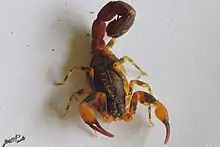Tityus bahiensis
Tityus bahiensis is a medically important scorpion endemic to South America.
| Tityus bahiensis | |
|---|---|
 | |
| Scientific classification | |
| Kingdom: | Animalia |
| Phylum: | Arthropoda |
| Subphylum: | Chelicerata |
| Class: | Arachnida |
| Order: | Scorpiones |
| Family: | Buthidae |
| Genus: | Tityus |
| Species: | T. bahiensis |
| Binomial name | |
| Tityus bahiensis Perty, 1833 | |
| Subspecies | |
| |
Description and behavior
It usually reaches 6 cm in length.[1] Its cephalothorax and tergites are dark, with reddish brown above, light legs with black spots, pedipalp is usually light brown, with a dark brown on the part of the tibia, the post-abdomen is pale brown, but often reddish-brown. its telson is reddish, the tips of the pincers and the stinger are brown or black, which is a way of identifying the species. the immature, are often reddish. Tityus bahiensis is a terrestrial and nocturnal scorpion, it is not aggressive, generally avoid humans, but if threatened it can attack.[2]
Diet
It feeds on cockroaches, tenebrian, crickets, spiders and insect larvae.
Range and habitat
they prefer the humid environments of the Atlantic forest and Cerrado forests, under woods and stones. The species is very common in agricultural areas.[2] The species occurs in Brazil( Minas Gerais, Goias, Sao Paulo, Mato grosso do sul and Parana), Argentina and Paraguay.[3]
Reproduction
The mating season can occur at any time of the year, but usually in November to April, the gestation time varies from 2 to 12 months, giving birth to between 2 and 25 juveniles.[3]
Venom
It is primarily responsible for envenoming in rural areas, and is often cited as the second most toxic of its kind, behind only T. serrulatus. Its neurotoxic venom causes symptoms such as severe pain, edema, sweating, lethargy, tachycardia, pulmonary edema, dyspnea, pancreatitis, gastrointestinal complications, nausea, vomiting and changes in blood pressure.[2] The LD50 for its venom is 0.5 mg/kg.[4]
References
- "Escorpionídeos". www.fiocruz.br. Retrieved 2020-09-17.
- https://www.acq.osd.mil/eie/afpmb/docs/lhd/venomous_animals_byspecies.pdf
- https://www.teses.usp.br/teses/disponiveis/41/41133/tde-28092010-112857/publico/SOutedaJorge_dissertation_2010.pdf
- Flindt, Rainer (2006-12-21). Amazing Numbers in Biology. Springer Science & Business Media. ISBN 978-3-540-30147-9.